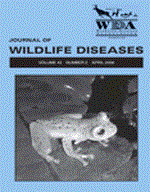Sixty-one birds of prey admitted to The Wildlife Center of Virginia (WCV; Waynesboro, Virginia, USA) from June to November 2003 were tested for West Nile virus (WNV) infection. Choanal and/or cloacal swabs were obtained and submitted to Virginia's Division of Consolidated Laboratory Services (Richmond, Virginia, USA) for analysis with real-time reverse transcriptase polymerase chain reaction (RT-PCR). Forty birds of prey were positive for WNV by RT-PCR. Five avian families and nine species of raptors were represented, with great horned owls (Bubo virginianus) and red-tailed hawks (Buteo jamaicensis) most frequently affected. Presenting clinical signs were consistent with previous reports of WNV infection in raptors; however, these differed between species. Of WNV positive birds, nonspecific signs of illness were the most common clinical findings, particularly in red-tailed hawks; signs included dehydration (n=20), emaciation (n=18), and depression (n=15). Neurologic abnormalities were frequently identified, especially in great horned owls, and included head tremors (n=17), ataxia (n=13), head incoordination (n=7), torticollis (n=3), nystagmus (n=3), and head tilt (n=3). Great horned owls exhibited anemia and leukocytosis with heterophilia, eosinophilia, and monocytosis consistent with chronic inflammation. Red-tailed hawks were anemic with a heterophilic leukocytosis and regenerative left shift. The majority of WNV cases occurred during August and September; there was a marked increase in the number of raptors admittedto WCV during these months followed by a marked decrease during October, November, and December. This pattern differed from mean monthly admissions during the previous 10 years and suggests a negative impact on local raptor populations. The effects of WNV on avian populations are largely unknown; however, because of their ecological importance, further investigation of the effects of WNV on raptor populations is warranted.
How to translate text using browser tools
1 April 2006
WEST NILE VIRUS IN RAPTORS FROM VIRGINIA DURING 2003: CLINICAL, DIAGNOSTIC, AND EPIDEMIOLOGIC FINDINGS
Priscilla H. Joyner,
Sean Kelly,
Allison A. Shreve,
Sarah E. Snead,
Jonathan M. Sleeman,
Denise A. Pettit

Journal of Wildlife Diseases
Vol. 42 • No. 2
April 2006
Vol. 42 • No. 2
April 2006
Bubo virginianus
Buteo jamaicensis
epidemiology
great horned owl
hematology
raptors
red-tailed hawk




